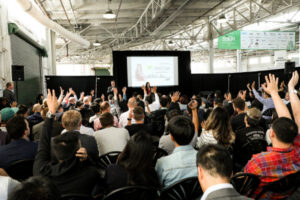When Amitava Saha and Supam Maheshwari first started in 2012, it was mainly for their baby products ecommerce company Firstcry. But just three years, in 2015, Xpressbees went on to become an independent company.
Six years later, today, it is present across 3000 cities, serving over 19,500 pincodes, and delivers over one million packages per day. In the last three financial years, from FY18 to FY21, it has grown 4x. Xpressbees now has over 100 hubs across India, 10 lakh sqft warehouse capacity, and 52 cargo airports.
“At Xpressbees, we have always worked with the aspiration of building the world’s best logistics operating platform (XB-LOP). Technology, therefore, plays a central and critical role in the Xpressbees business ecosystem,” says Amitava.
While building the platform, the team reviewed various market products, but those were rigid and did not accommodate experimentation. “We believe logistics is not a closed box for technology solutions. There is a huge need for innovation and experimentation to optimise operations. So, we ensured our system is built on the foundations of ground experiments and real data matrix from operations,” explains Amitava.
According to him, the logistics domain is a fundamental backbone of India’s $5 trillion economy dream. In designing the company’s technology platform, the team has considered this scale and the need for seamless performance in the highly dynamic Indian business landscape.
Building the workflows
“Our next, new generation unified intelligent platform includes 27 core intelligent frameworks to control all aspects of the Indian logistic business, including geographical challenges. All our business verticals are fully integrated with this core technology platform to reuse all types of assets, resources, and manpower,” says Amitava.
He adds that over 75 percent of Xpressbees’ operations run on fully automated, technology-driven workflows and material movement processes. “Collectively, this enables the team to run our operations with enhanced cost efficiencies, speed, agility, accountability, and visibility.”
“Our multi domain expertise and knowledge in ecommerce helped us build the first core logistic platform. Our first product was designed to facilitate shipment movement from one location to another location. We worked with a very small but, willing to experiment team, and took almost two months to go live. This team was a combination of domain specialists and non-domain technology experts, pushing us to design workflows that were intuitive and hand-in-glove with ground realities,” explains Amitava.
From the beginning, the core technology team was driven to build India’s best logistic platform. Hence, factors like scale, performance, elasticity, flexibility, experimentation and core platform-based framework architecture were always the big criteria.
“Our biggest learning during the evolution of our products is that on-ground experiments and continuous inputs from users –operation teams in our case – is the secret ingredient to relevant, effective products. Our technology experts spend hours with operations teams on the field to understand the realities they work in, and then come back to the technology drawing board to convert them into ideal, efficient material movement workflows and supporting technologies,” says Amitava.
Building a unified logistics platform
He explains the team has been running this technology platform for the last eight years, and they believe the new unified intelligent logistic platform will run for the next decade to support high scale, performance, and evolution of business models.
“We have robust feedback flow on all sides and have ambassadors within operations. These ambassadors help us understand on-ground gaps in real time and enable us to fix them with no or minimal lag. Also, we have a robust system-driven flow to collect feedback from our clients and include them in our product roadmap. These swift feedback loops drastically impact the longevity and agility of our technology platform to suit the changing needs of our business,” adds Amitava.
The team started with core logistics for ecommerce, and then built a central technology platform for various core logistic operations. From the time of its inception, the team has worked with the goal to build a central platform for all logistics processes.
“So, while expanding our business in different logistic verticals, our technology platform helped us build fast workflows of various first mile, mid mile, and last-mile use cases,” says Amitava.
The USP of the platform resides in its flexibility, high experimentation capability, multi-layered rollout capability, and fast automation capability with less human intervention.
And now, with its high-end technology platforms and technology-driven material movement strategies, Xpressbees has evolved from a small-scale logistic player to a national player.
“Our new intelligent technology platform is a highly distributed and highly scalable model built on microservices-based architecture which is ready to support next level of scale and performance,” says Amitava.
Building the tech in house
“In Xpressbees, technology is evolving every day, and we have different types of processes and mechanisms to get system feedback and process feedback. We also do lots of on-ground experimentation on the fly to upgrade our system and processes at regular intervals. And while bringing in further enhancement, we always keep our core factors in mind to support our company goals and next level of business scale,” says Amitava.
The entire technology is built in-house and the team believes that to bring differentiation and become a winner in a specific domain, you have to have full control on technology and operation process.
This gives flexibility and speed in experimentation, control on the system workflows and process to reduce cost or increase productivity across various operations.
Besides mapping and checking productivity impacts and process improvements, Amitava says the team did a lot of experiments on scale, performance and core logistic business processes. That helped the team design the ideal Xpressbees business model.
What the team gained through this journey was improved productivity and reduced operations cost across various verticals. For example –
- Smart visibility — the team has designed intelligent platforms to predict productivity, operation matrix and benchmark those stats with industry standards. These give clear visibility to the operations team to take the right action at the right time.
- Address fix engine — Customer address is very big problem in a country like India. To solve this, the team has built their own cell and grid based address fix engine, which helps first mile and last mile teams to identify the exact address location of a vendor or a customer. This has helped them reduce travel time and fuel cost.
- DWS machine — the team has successfully designed fully automated hardware and software for shipment dimensions and weight in 1/5th cost of market product.
- Mobile sorting van — this is another innovation to help them work close to the client locations. The mobile sorter van helps save operation time by 30 percent.
The logistics sector earned infrastructure status in 2017, when its market size was estimated at $160 billion. According to IBEF, the Indian logistics market reached $215 billion in 2020, logging a 10.5 percent CAGR over 2017. The growth trajectory according to the report will continue for the next few years. The segment has several players, including Locus, Blackbuck, LetsTransport, and others.
Speaking of the future, Amitava says,
“We are expanding our team structures and building multi-location teams to hire diverse talent and experts in various technology areas. Today, we have 250 experts in technology, and plan to expand it to 350. Now, the team is working on AI/ML technologies to build the next generation smart and intelligent systems,” says Amitava.
YS’s flagship startup-tech and leadership conference will return virtually for its 13th edition on October 25-30, 2021. Sign up for updates on TechSparks or to express your interest in partnerships and speaker opportunities here.
For more on TechSparks 2021, click here.
Applications are now open for Tech30 2021, a list of 30 most promising tech startups from India. Apply or nominate an early-stage startup to become a Tech30 2021 startup here.

![You are currently viewing [Product Roadmap] How XpressBees makes over one million orders every day through its logistics platform](https://blog.digitalsevaa.com/wp-content/uploads/2021/08/Xpress-34-1629218033690.png)

![Read more about the article [Jobs Roundup] Here’s how you can work for Indo-US SaaS unicorn Druva](https://blog.digitalsevaa.com/wp-content/uploads/2021/04/Dhruva-02-1595339630168-300x150.png)
![Read more about the article [Tech50] Deep diving into the journey of deeptech startup Jidoka Technologies: one innovation at a time](https://blog.digitalsevaa.com/wp-content/uploads/2021/12/JidokafoundersFinal-1640180983862-300x150.jpg)





